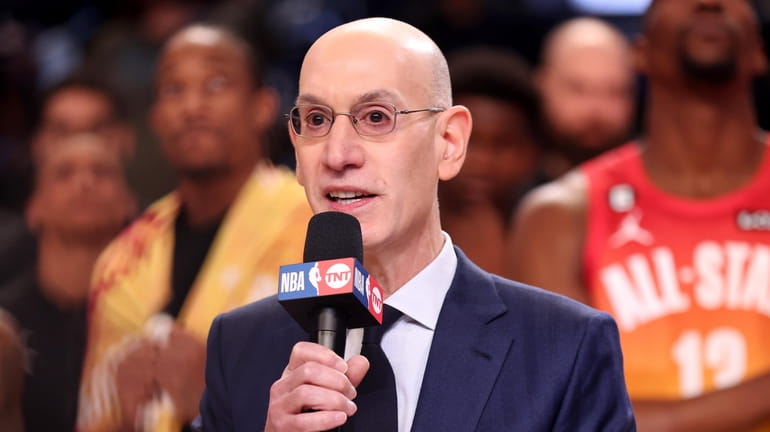NBA In-Season Tournament: Can Adam Silver get you to care about the NBA now instead of after Christmas?

NBA Commissioner Adam Silver talks after the 2023 NBA All Star Game between Team Giannis and Team LeBron at Vivint Arena on February 19, 2023 in Salt Lake City, Utah. Credit: Getty Images
Nobody really cares about the NBA until Christmas.
The season is just way too long for all but the biggest East Coast diehard hoop heads to stay up to watch a 10 p.m. nationally televised game between, say, the Memphis Grizzlies and the Portland Trail Blazers in early November. What’s more, with the load management that has gone on in recent years, fans haven’t even been able to count on superstars being able to play in these games.
While this is not a new problem, it has become a pretty important one as the NBA’s current media deal ends at the close of the 2024-25 season, which means they can start negotiating with their current broadcasting partners — ESPN, ABC and TNT — in March and other interested parties, including Amazon, a month later.
In a somewhat risky attempt to make fans care about the first two months of the season, the league has decided to launch an in-season tournament, the first games of which will be played this Friday night with a championship game to be played Dec. 9 in Las Vegas.
The whole thing is a little hard to get your head around, but here’s my CliffsNotes explanation.
The league has been divided into six five-team groups with teams playing the other four games in their group in a tournament game once. Every Tuesday and Friday in November, except on election day when there are no games, has been designated at a "tournament night" with all games on the schedule counting as tournament games as well as regular-season games.
The six group winners and the two wild card teams with the best records make the quarterfinals. Quarterfinal games are Dec. 4 and 5 at higher seeds; the semifinals are Dec. 7 in Las Vegas and the title game is Dec. 9 in Las Vegas.
The 22 teams that don’t make the quarterfinals will play still-to-be-scheduled regular-season games on Dec. 6 and Dec. 8. Also on the Dec. 8 schedule: regular-season games between the teams that lose quarterfinal games. So every team in the league will end up playing 82 games, except for those playing in the championship game which will play 83, though the championship game won’t count in the standings.
Could this bring in more viewers? Hard to say. There could be a curiosity factor working in the league’s factor. (Hey, have you heard about the brightly colored special new tournament courts?) It also, however, could usher in some more problems.
For example, what really is the advantage for a team to win their group and advance to the playoff round? Are teams really going to be that pumped up to hang a “2023 In tournament championship banner” from the rafters? Since the quarterfinal and semifinal games count in the regular-season standings, wouldn’t it be more advantageous to be one of the 22 teams that don’t advance?
Let’s say the Knicks make it to the semifinals, where they have to play a tough team like the Boston Celtics. Let’s say they lose that game and then at the end of the regular season, miss out on getting the seed they wanted by a game? Wouldn’t it have been better if they never made the tournament and played the Charlotte Hornets or Washington Wizards?
And while there is some money at stake — each player on the championship team gets $500,000 while players on second-place team earn $200,000, the losing players of the semifinals each get $100,000 and the losing players of the quarterfinals each get $50,000 — wouldn’t it be much more interesting to the fans if there was something else at stake that impacted the regular season? Like an automatic playoff berth? Or homecourt advantage throughout the playoffs?
Finally, there’s the small, but not infinitesimal chance, that someone from a really good team gets hurt in that 83rd game, the championship game.
The NBA already has big problems trying to get its stars to play in a large number of games. Gone are the days when Michael Jordan played all 82 games of the regular season. The league tried to fix that with its new player participation policy that multiple players and teams have already ignored.
Of course, the easiest way to avoid injuries and get more fans to care about the regular season would be to cut down on the number of games. Don’t hold your breath there. The tournament and making stars play is all about revenue, all about setting a record with a new contract that some predict could be worth triple the one that pays the league an average of $2.7 billion annually.
It will be interesting to see if the experiment is worth it. I’m not sure a fancy court and a meaningless tournament is going to get a lot of people to turn into Friday night's Grizzlies-Trail Blazers game.
WHAT TO KNOW
- This is the first time the NBA is holding an in-season tournament.
- The inaugural tournament starts on Friday and continues through Nov. 28 in the group stage. The knockout stage follows with single-elimination games starting with the quarterfinals, which will take place on Dec. 4-5 in the team markets. The semifinals will take place on Dec. 7, with the championship on Dec. 9. The semifinals and championship will be held at T-Mobile Arena in Las Vegas.
- All 30 teams have been randomly drawn into groups of five within their conference based on records from the 2022-23 season. Teams will play group stage games on "tournament nights," with one game each against teams in their group (two at home and two on the road). The Knicks are in East Group B with the Milwaukee Bucks, Miami Heat, Charlotte Hornets and Washington Wizards. The Nets are in East Group C with the Boston Celtics, Toronto Raptors, Chicago Bulls and Orlando Magic.
- The top six teams in each group (based on record) and two wild cards (one team from each conference with the best record from the group stage that finished second in their group) will advance to the knockout stage.
- All games in the in-season tournament count toward the regular-season standings, except the championship game. All teams will continue to play 82 regular-season games. The 22 teams that do not qualify for the knockout stage will play two regular-season games. The four losers in the quarterfinal games will play against an opponent in the same conference on Dec. 8.
- There is a prize pool for the players on teams that advance to the knockout stage. Players on the title winning team will each get $500,000, while players on the runner-up team will each get $200,000. The losing players on the semifinal teams will each get $100,000 and the losing players on the quarterfinal teams will each get $50,000. An MVP will be chosen and all-tournament teams selected at the conclusion of the tournament.

